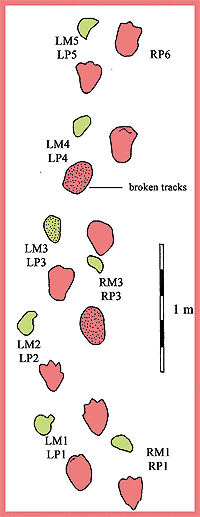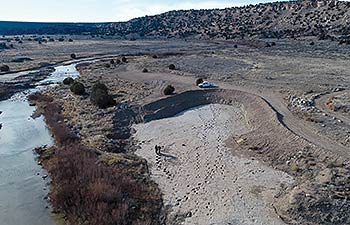 |
| Moab’s most important Morrison Formation tracksite shows a stegosaur trackway (formally named Deltapodus), and discovered by local resident Sue Sternberg. Ten hind (or pes) footprints (P) and seven front (or manus) footprints (M) and were identified. Missing front footprints are due to poor preservation, not unusual changes in gait. |
Well-informed dinosaur paleontologists and enthusiasts will have heard of the Upper Jurassic Morrison Formation, named after the small town in the foothills 20 minutes southwest of downtown Denver. This is where Jurassic dinosaur hunting began in the wild west in 1877, spreading first to Wyoming and then by the early 1900s to the Grand Junction and Dinosaur National Monument areas - two of the apexes of today’s Dinosaur Diamond. I hear you say- “we already know this; we have read John Foster’s book Jurassic West” and know that there are hundreds of sites (250-300) that have yielded bones ranging from giant dinosaurs to other vertebrates including mouse-sized mammals.
But what about other Morrison evidence of Dinosaurs and Late Jurassic life such as tracks and eggs, not to mention, gastroliths, coprolites and plants? Well, starting with tracks, my favorite subject, there are about 75 known tracksites which gives us a ratio of bone to track sites of about 4 to 1. The largest dinosaur tracksite is found in SE Colorado in the Purgatoire Valley (not to be confused with the Purgatory Resort area in SW Colorado). The tracks from the Purgatoire area (French, trapper-era spelling) or Rio de Animas Perdidas (“river of lost souls”) has been known to locals since the 1910s decade, but was not reported until the 1930s, when pictures appeared in Life magazine and Scientific American. This river bottom site was mapped by a CU Denver team in the 1980s and shown to be “North America’s largest tracksite” (article title) with ~1300 tracks. Since then, new excavations have expanded the site to reveal 2,100 tracks, ranking it as one of the largest and best studied sites in the world. The Purgatoire site reveals only theropod and sauropod trackways, the latter showing parallel trackways strongly suggestive of a herd heading west: an early Jurassic ‘Santa Fe Trail.’
Yes! the Purgatoire site is a long way (300 + miles) from Moab and the Dinosaur Diamond but it can be visited after a long track across the prairies of the Comanche National Grasslands, and moreover it ranks in the top 12 sites globally for size, number of tracks and other factors such as accessibility. So how do the Morrison sites in the Dinosaur Diamond stack up against this super site? First there are quite a few; the Copper Ridge site being among the most accessible with deep tracks of a sauropod turning right (no political jokes please)! Then there is the only Morrison site with a stegosaur trackway, found by Sue Sternberg, a local resident. Stegosaurs it seems are more common as skeletal remains than as tracks.
A formation like the Morrison with 75 tracksites is useful as a census of different types of animals and where they lived. For example, ~95% of all tracks were made by theropods and sauropods while the remaining ~5% mostly represent turtles and crocodiles. This tells us the rivers and lakes were rich in aquatic life. Eggs, including one attributed to an Allosaurus, are known at some sites in nests, as reported from the Grand Valley area. One plant rich locality was recently nicknamed “the salad bar.” All in all, the Morrison Formation has been, since its first discovery, a rich source of Upper Jurassic floral and faunal evidence. At least one theropod coprolite is known from the Morrison Formation in the San Rafael area, containing bone bored by beetles, and a presumed “regurgitalte” (you can translate!) shows where some species “threw up” a meal of small amphibians including remains of a rare frog. This only leaves gastroliths (belly boulders or stomach stones) those polished stones that are easy to find and hard to identify except when found in the belly area of near complete skeletons. No doubt Paleontologist will soon throw up new fossil evidence for us to marvel at!
 |
| The Purgatoire or Picketwire trackside in SW Colorado is the largest and most spectacular in the Morrison Formation. It ranks number 4 in the USA, and number 12 in the world, among all dinosaur tracksites. |
|